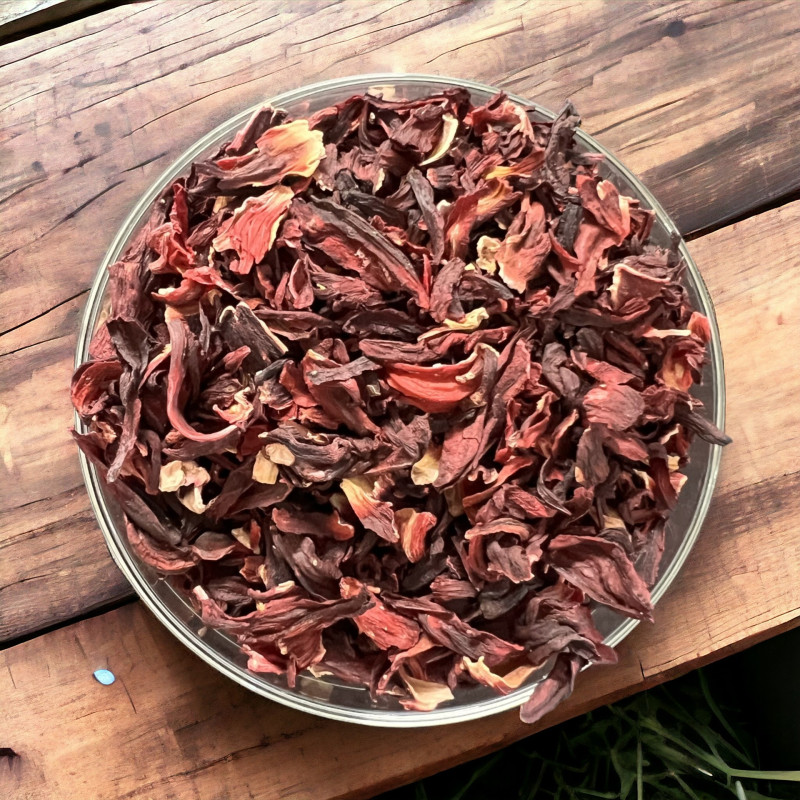
Reference: bleuet


The color of these flowers is a stunning garnet, and their taste surprises with its acidity.
With them, you can make refreshing drinks, syrups, jams, ice creams, and even sauces for fish dishes.
 Delivery
Delivery
Mondial Relay
 Returns
Returns
See conditions
 Payments
Payments
100% secure
Livré en sachet refermable
°°°
Uses in Cooking and Beyond:
These beautiful red flowers of Hibiscus sabdariffa, native to West Africa, are dried and infused to make refreshing, tangy beverages with a stunning cherry-red color, typically enjoyed sweetened. Hibiscus is also used to add a tart flavor and vibrant color to jams, ice creams, and even some fish sauces. Infused hibiscus petals transfer their striking red hue to any dish they’re added to.
For an infusion, use 3 to 4 flowers per cup, steeped in hot water for 4 to 10 minutes, depending on the desired strength. Hibiscus can also be enjoyed in combination with tea, hot or cold.
In Africa, especially in Senegal, a sweetened drink called "bissap" is made by steeping hibiscus flowers in hot water, similar to brewing tea. The drink is served chilled, sometimes with mint, though it can also be enjoyed hot. Rich in ascorbic acid (giving it a tart flavor) and vitamins C and A, it is known as "karkadé" in Egypt and Lebanon, and it’s wonderfully refreshing and perfect for summer!
A fun idea: place a hibiscus flower at the bottom of a champagne glass, creating a beautiful pink hue that rises with the bubbles and adds a subtle tangy flavor—delightfully playful!
The food industry often uses hibiscus for its coloring properties (for example, in red fruit tea blends), giving the impression of actual red fruits without their presence.
Hibiscus contains no caffeine or theine, making it suitable for evening consumption (though consider its vitamin C content).
For dark hair, rinsing with hibiscus infusion brings out beautiful auburn highlights.
Who am I?
Origin: Egypt
Scientific name: Hibiscus sabdariffa
Common names: Roselle, Guinea sorrel, karkadé, bissap
In regions where it’s cultivated, Hibiscus sabdariffa also produces shoots and young leaves, which are consumed raw or cooked as vegetables.
Hibiscus plants, annual or perennial, include over 30,000 varieties. Hibiscus sabdariffa is among them, known since ancient times and cultivated in Egypt and Asia for its ornamental appeal and edible flowers. The shrub can grow up to 5 meters tall and wide.
The flowers, twisted before fully opening, appear from March to October. They are large, with a long central tube formed by the fusion of five stamens, with a long style inside. Harvested in summer and autumn, the fruits are capsules that release their often hairy seeds when mature.
A Little History:
Hibiscus plants were imported to Europe in the 12th century by the Moors, and certain species were later introduced to America in the 17th century by enslaved Africans.
Data sheet
 Catherine G.
Catherine G.
très bon produit. Les fleurs sont entières contrairement à d'autres sociétés où l'on reçoit de la "poussière" d'ibiscus.
 Philippe D.
Philippe D.
?

 Catherine G.
Catherine G.
très bon produit. Les fleurs sont entières contrairement à d'autres sociétés où l'on reçoit de la "poussière" d'ibiscus.
 Philippe D.
Philippe D.
?

Reference: bleuet
Reference: 10M6810601
Reference: souci
Reference: jasmin
Reference: 408190301
Reference: camomilleRom
Reference: rosepetale
Reference: mauve
Reference: bleuet
Reference: rosepetale
Reference: 26545D

The color of these flowers is a stunning garnet, and their taste surprises with its acidity.
With them, you can make refreshing drinks, syrups, jams, ice creams, and even sauces for fish dishes.